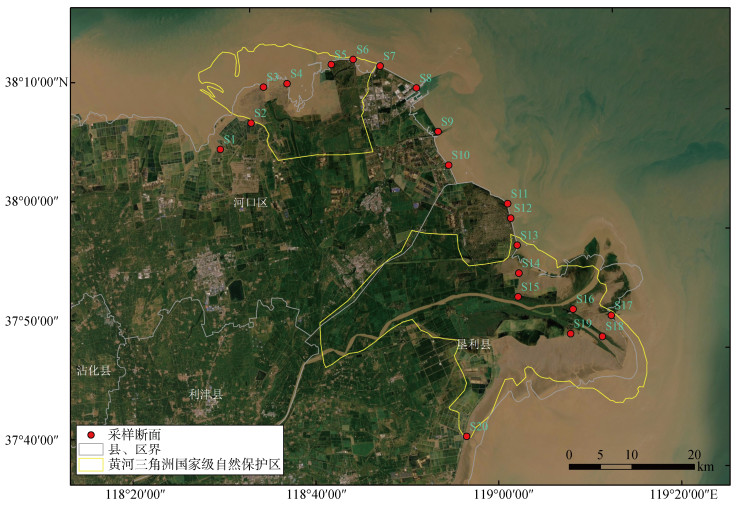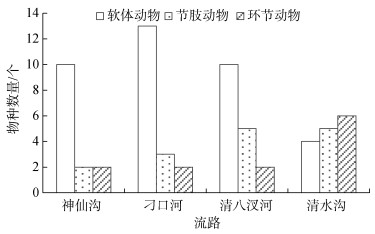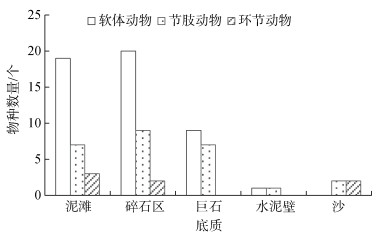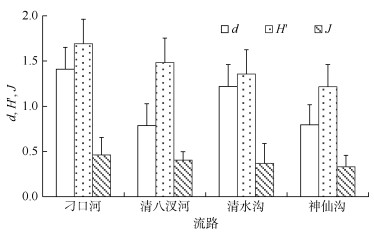
文章信息
- 史会剑, 李玄, 王海艳, 马培振, 张文文, 雍凡, 崔鹏, 吴翼. 2021.
- SHI Hui-jian, LI Xuan, WANG Hai-yan, MA Pei-zhen, ZHANG Wen-wen, YONG Fan, CUI Peng, WU Yi. 2021.
- 黄河三角洲潮间带大型底栖无脊椎动物群落结构与分布特征
- Community characteristics and spatial distribution of invertebrate macrobenthos in intertidal zone of the Yellow River Delta
- 海洋科学, 45(2): 11-21
- Marine Sciences, 45(2): 11-21.
- http://dx.doi.org/10.11759/hykx20200419001
-
文章历史
- 收稿日期:2020-04-19
- 修回日期:2020-09-10
2. 中国科学院海洋研究所/中国科学院海洋大科学研究中心, 山东 青岛 266071;
3. 生态环境部南京环境科学研究所自然保护与生物多样性研究中心/国家环境保护武夷山生态环境科学观测研究站/武夷山生物多样性综合观测站/国家环境保护生物安全重点实验室, 江苏 南京 210042
2. Institute of Oceanology, Chinese Academy of Sciences/Center for Ocean Mega-Science, Chinese Academy of Sciences, Qingdao 266071, China;
3. Research Center for Nature Conservation and Biodiversity, Nanjing Institute of Environmental Sciences, Ministry of Ecology and Environment/State Environmental Protection Scientific Observation and Research Station for Ecological Environment of Wuyi Mountains/Biodiversity Comprehensive Observation Station for Wuyi Mountains/State Environmental Protection Key Laboratory on Biosafety, Nanjing 210042, China
潮间带是海岸滩涂湿地的重要组成部分, 根据潮汐活动的规律, 潮间带又可以分为三个区: 高潮区、中潮区、低潮区[1]。作为海岸带最具生态价值和生物多样性的地带, 潮间带生境的变化通常导致潮间带底栖生物物种多样性、数量和群落结构发生改变[2]。因此, 研究底栖生物资源现状对了解潮间带环境状况、开展潮间带生物资源保护具有重要意义[3]。国内外学者针对潮间带底栖动物开展了大量研究, 主要集中在群落结构与多样性、分布格局与时空变化、群落演替、生态位及污染生态学等方面[4-11]。
作为我国最年轻、最具开发潜力的河口湿地, 同样也是世界上生物多样性水平最高的湿地之一, 黄河三角洲已经成为国内湿地研究的热点, 而其生态系统的脆弱性和敏感性则逐渐成为科研工作中较为关注的问题[12-13]。本研究依据2019年5月黄河三角洲潮间带调查结果, 比较、分析了建国后4个主要的黄河入海流路潮间带大型底栖无脊椎动物多样性和群落结构状况, 旨在为黄河三角洲潮间带生物资源保护和修复提供基础数据与理论支撑。
1 材料与方法 1.1 研究区域山东黄河三角洲国家级自然保护区于1992年10月经国务院批准建立, 是以保护黄河口湿地生态系统和珍稀濒危鸟类为主体的湿地类型自然保护区。总面积15.3万ha, 其中核心区5.94万ha, 缓冲区1.12万ha, 试验区8.24万ha。分为南北两个区域: 南部区域位于现行黄河入海口, 面积10.45万ha; 北部区域位于1976年改道后的黄河故道入海口, 面积4.85万ha。由于黄河是世界上泥沙含量最高的河流, 黄河泥沙在河口附近大量淤积, 使河道不断向内海延伸, 河口侵蚀基准面不断抬高, 河床逐年上升, 当淤积发生到一定程度时就发生尾闾改道。本研究调查区域主要是建国后不同时期的4个黄河入海口区域, 分别是1953-1964年间神仙沟流路区域、1964-1976年间刁口河流路区域、1976-1996年间清水沟流路区域, 以及1996-2019年的清八汊河流路及周边区域。
黄河流路改变、海水侵蚀、调水调沙及生态调水工程等影响对海岸线产生显著影响, 旧黄河流路的海岸线受海洋侵蚀后退, 清八汊河流路沿河道延伸, 泥沙淤积造新陆地; 自然类型转向人工类型, 水体和滩涂等自然类型持续减少, 盐田和养殖池等人工类型逐渐增多[14]。然而, 潮间带湿地与海域之间呈淤进-蚀退交替变化特征, 油田开发和码头建设导致湿地大面积开发。2010年后, 潮间带湿地面积的减少速度呈减缓趋势并出现小幅增加, 这主要与潮间带湿地的生态保育、科学管理水平提高以及调水调沙工程的长期实施有关[15]。
1.2 站位设置与样品采集2019年5月对建国后4个主要的黄河入海流路区域, 南起防潮坝的小岛河渔港, 沿海岸线北上并折西, 西至刁口乡西北侧码头。调查共设站位20个, 每个流路区域设站位5个(图 1)。其中, S1-S5为刁口河流路, S6-S10为神仙沟流路, S11-S15为清八汊河流路, S16-S20为清水沟流路。S1、S2、S4、S13-S21站点为泥滩地, 以滩涂植物翅碱蓬(Suaeda heteroptera)、大米草(Spartina anglica)以及外来入侵物种互花米草(Spartina alterniflora)为主; 其余站点以碎石滩和水泥壁为主。S2-S6, S13-S20位于黄河三角洲国家级自然保护区内, 主要为刁口河和神仙沟流路区域。每站位设高潮带、中潮带和低潮带3个±1个断面, 依据各站位潮间带滩面的不同宽度和现场调查的实际情况, 进行部分站位的定性或定量采样。采样方法按照中华人民共和国国家标准《海洋调查规范第6部分: 海洋生物调查》(GB/T12763.6-2007)[16], 用30 cm×30 cm×30 cm的定量框取样, 筛网孔目1.0 mm, 原则上每站位取3个样方。为弥补因面积限制造成种类不全的缺陷, 在各站位附近进行定性标本的采集, 采集面积3 m×3 m。所有底栖动物样品取回后立即用95%的酒精保存, 带至实验室分析鉴定, 并进行数据分析。
 |
| 图 1 调查站位分布图 Fig. 1 The location of the survey stations |
数据处理和分析采用EXCEL软件。依据定量调查结果统计栖息密度和生物量: 单位面积内底栖动物的数目即栖息密度(单位: 个/m2); 生物量计算方法是根据底栖动物所有样品带回实验室称量湿重质量(单位: g/m2)。分别以优势度指数、Margalef丰富度指数、Shannon-Wiener多样性指数和Pielou均匀度指数对大型底栖生物群落结构进行分析, 计算公式如下。
优势度指数(Y):
| $ Y = {P_i}{f_i}, $ | (1) |
Margalef物种丰富度指数(d):
| $ d = \left({S - 1} \right)/{\log _2}N, $ | (2) |
Shannon-Wiener多样性指数(H'):
| $ H' = - \sum\nolimits_i^S {{P_i}{{\log }_2}{P_i}} , $ | (3) |
Pielou均匀度指数(J):
| $ J = H'/{\log _2}S, $ | (4) |
式中: Pi是物种i的个体数与总个体数的比值, fi为物种i在各站位出现的频率; S为样方内的总物种数; N为样方内所有物种的总个体数。当Y≥0.02时, 该种确定为优势种[17]。
采用PRIMER 7软件根据物种生物密度(个/m2)平方根转换计算Bray-Curtis相似性系数矩阵, 采用软件包中等级聚类分析(Hierarchical cluster analysis)进行群落结构分析[18]。
采用SPSS 19.0软件对不同流路进行方差分析, 并对各组之间用最小显著极差法(LSR)进行多重比较, 显著水平0.05, 进行各流路间差异性分析。
2 结果与分析 2.1 物种组成与优势种调查共记录潮间带大型底栖无脊椎动物3门5纲16目37科50属60种(表 1, 表 2)。其中, 环节动物多毛类7种, 节肢动物18种, 软体动物35种。软体动物和节肢动物占88.3%, 是该区域潮间带大型底栖无脊椎动物的是最主要类群。
| 门 | 分类阶元/个 | 物种数占总物种数比例/% | ||||
| 纲 | 目 | 科 | 属 | 种 | ||
| 环节动物门 | 1 | 4 | 4 | 6 | 7 | 11.5 |
| 节肢动物门 | 2 | 4 | 13 | 17 | 18 | 31.1 |
| 软体动物门 | 2 | 8 | 20 | 27 | 35 | 57.4 |
| 分类阶元总计 | 5 | 16 | 37 | 50 | 60 | 100 |
| 纲 | 目 | 科 | 属 | 种 |
| 多毛纲 Polychaeta |
叶须虫目 Phyllodocia | 吻沙蚕科 Glyceridae | 吻沙蚕属 Glycera | 长吻沙蚕 G. chirori |
| 沙蚕目 Nereidida | 沙蚕科 Nereididae | 刺沙蚕属 Neanthes | 日本刺沙蚕 N. japonica | |
| 全刺沙蚕属 Nectoneanthes | 全刺沙蚕 N. oxypoda | |||
| 围沙蚕属 Perinereis | 双齿围沙蚕 P. aibuhitensis | |||
| 多齿围沙蚕 P. nuntia | ||||
| 矶沙蚕目 Eunicida | 索沙蚕科 Lumbrineridae | 索沙蚕属 Lumbrineris | 索沙蚕属一种 L. sp. | |
| 囊吻目 Scolecida | 锥头虫科 Orbiniidae | 锥头虫属 Orbinia | 膜囊尖锥虫 O. marsupialis | |
| 腹足纲 Gastropoda |
原始腹足目 Archaeogastropoda |
笠贝科 Lottiidae | 拟帽贝属 Patelloida | 圆锥拟帽贝 P. conulus |
| 矮拟帽贝 P. pygmaea | ||||
| 拟帽贝属一种 P. sp. | ||||
| 笠贝科一种 L. sp. | ||||
| 马蹄螺科 Trochidae | 单齿螺属 Monodonta | 单齿螺 M. labio | ||
| 凹螺属 Chlorostoma | 锈凹螺 C. rustica | |||
| 䗉螺属 Umbonium | 托氏䗉螺 U. costatum | |||
| 中腹足 Mesogastropoda | 滨螺科 Littorinidae | 滨螺属 Littorina | 短滨螺 L. brevicula | |
| 拟滨螺属 Littoraria | 粗糙拟滨螺 L. scabra | |||
| 拟沼螺科 Assimineidae | 拟沼螺属 Assiminea | 绯拟沼螺 A. latericea | ||
| 滩栖螺科 Batillariidae | 滩栖螺属 Batillaria | 古氏滩栖螺 B. cumingi | ||
| 腹足纲 Gastropoda |
中腹足 Mesogastropoda | 玉螺科 Naticidae | 镰玉螺属 Lunatia | 镰玉螺属一种 L. sp. |
| 扁玉螺属 Neverita | 扁玉螺 N. didyma | |||
| 新腹足目 Neogastropoda | 骨螺科 Muricidae | 红螺属 Rapana | 脉红螺 R. venosa | |
| 荔枝螺属 Thais | 疣荔枝螺 T. clavigera | |||
| 核螺科 Columbellidae | 小笔螺属 Mitrella | 丽小笔螺 M. bella | ||
| 织纹螺科 Nassariidae | 织纹螺属 Nassarius | 秀丽织纹螺 N. festivus | ||
| 红带织纹螺 N. succinctus | ||||
| 笋螺科 Terebridae | 笋螺属 Terebra | 朝鲜笋螺 T. koreana | ||
| 泰氏笋螺 T. tayori | ||||
| 头楯目 Cephalaspidea | 阿地螺科 Atyidae | 泥螺属 Bullacta | 泥螺 B. exarata | |
| 基眼目 Basommatophora | 菊花螺科 Siphonariidae | 菊花螺属 Siphonaria | 日本菊花螺 S. japonica | |
| 双壳纲 Bivalvia |
帘蛤目 Veneroida | 蛤蜊科 Mactridae | 蛤蜊属 Mactra | 中国蛤蜊 M. chinensis |
| 四角蛤蜊 M. veneriformis | ||||
| 樱蛤科 Tellinidae | 明樱蛤属 Moerella | 彩虹明樱蛤 M. iridesens | ||
| 截蛏科 Solecurtidae | 缢蛏属 Sinonovacula | 缢蛏 S. constricta | ||
| 棱蛤科 Trapeziidae | 棱蛤属 Trapezium | 纹斑棱蛤 T. liratum | ||
| 帘蛤科 Veneridae | 镜蛤属 Dosinia | 日本镜蛤 D. japonica | ||
| 蛤仔属 Ruditapes | 菲律宾蛤仔 R. philippinarum | |||
| 文蛤属 Meretrix | 短文蛤 M. petechialis | |||
| 青蛤属 Cyclina | 青蛤 C. sinensis | |||
| 绿螂科 Glauconomidae | 绿螂属 Glauconome | 薄壳绿螂 G. primeana | ||
| 海螂目 Myoida | 篮蛤科 Corbulidae | 河篮蛤属 Potamocorbula | 光滑河篮蛤 P. laevis | |
| 焦河篮蛤 P. ustulata | ||||
| 笋螂目 Pholadomyoida | 鸭嘴蛤科 Laternulidae | 鸭嘴蛤属 Laternula | 渤海鸭嘴蛤 L. marilina | |
| 颚足纲 Maxillopoda |
无柄目 Sessilia | 小藤壶科 Chthamalidae | 小藤壶属 Chthamalus | 东方小藤壶 C. challenger |
| 藤壶科 Balanidae | 管藤壶属 Fistulobalanus | 白脊管藤壶 F. albicostatus | ||
| 泥管藤壶 F. kondakovi | ||||
| 软甲纲 Malacostraca |
端足目 Amphipoda | 藻钩虾科 Ampithoidae | 藻钩虾属 Ampithoe | 强壮藻钩虾 A. volida |
| 蜾赢蜚科 Corophiidae | 独蜾赢蜚属 Monocorophium | 独蜾赢蜚属一种 M. sp. | ||
| 等足目 Isopoda | 团水虱科 Sphaeromatidae | 凹尾水虱属 Dynamenella | 凹尾水虱属一种 D. sp. | |
| 海底水虱属 Dynodies | 海底水虱属一种 D. sp. | |||
| 海蟑螂科 Ligiidae | 海蟑螂属 Ligia | 海蟑螂 L. exotica | ||
| 十足目 Decapoda | 鼓虾科 Alpheidae | 鼓虾属 Alpheus | 叶齿鼓虾 A. lobidens | |
| 泥虾科 Laomediidae | 泥虾属 Laomedia | 泥虾 L. astacina | ||
| 宽背蟹科 Euryplacidae | 强蟹属 Eucrata | 隆线强蟹 E. crenata | ||
| 玉蟹科 Leucosiidae | 拳蟹属 Philyra | 豆形拳蟹 P. plsum | ||
| 梭子蟹科 Portunidae | 蟳属 Charybdis | 日本蟳 C. japonica | ||
| 弓蟹科 Varunidae | 拟厚蟹属 Helicana | 伍氏拟厚蟹 H. wuana | ||
| 厚蟹属 Helice | 天津厚蟹 H. tientsinensis | |||
| 近方蟹属 Hemigrapsus | 绒螯近方蟹 H. longitarsis | |||
| 新绒螯蟹属 Neoeriocheir | 狭额新绒螯蟹 N. leptognathus | |||
| 大眼蟹科 Macrophthalmidae | 大眼蟹属 Macrophthalmus | 日本大眼蟹 M. japonicus |
4个调查地点中, 刁口河流路的种类数最多(18种), 清八汊河流路次之(17种), 其余依次为清水沟流路和神仙沟流路, 分别为15和14种(图 2)。清水沟流路以多毛类和节肢动物为主, 其余流路则以软体动物为主。从底质情况分析, 碎石区和泥滩记录的动物种类数最多, 分别为31和29种; 防浪巨石处种类为16种; 水泥壁和沙底质最少, 各发现2种(图 3)。其中, 碎石、泥滩和巨石底质以软体动物为主, 而沙底质则以环节动物多毛类和节肢动物为主。
 |
| 图 2 黄河三角洲潮间带不同流路大型底栖无脊椎动物物种数 Fig. 2 The richness of invertebrate macrobenthos in four flow paths to the sea in intertidal zone of the Yellow River Delta |
 |
| 图 3 黄河三角洲潮间带不同底质大型底栖无脊椎动物物种数 Fig. 3 The richness of invertebrate macrobenthos in sediment type in intertidal zone of the Yellow River Delta |
黄河三角洲潮间带大型底栖无脊椎动物的优势种在不同流路区域间存在明显差异(表 3)。总体来看优势种以软体动物为主, 为9种, 节肢动物有2种。刁口河流路分布有最多的优势种, 包括托氏䗉螺(Umbonium costatum)、泥螺(Bullacta exarata)、光滑河篮蛤(Potamocorbula laevis)、彩虹明樱蛤(Moerella iridescens)、四角蛤蜊(Mactra veneriformis)和日本大眼蟹(Macrophthalmus japonicus)等。神仙沟流路采集到大量的短滨螺(Littorina brevicula)、东方小藤壶(Chthamalus challengeri)和日本菊花螺(Siphonaria japonica), 清八汊河以短滨螺、东方小藤壶、薄壳绿螂(Glauconome primeana)和锈凹螺(Chlorostoma rustica)为主, 而清水沟流路优势种最少, 仅有日本大眼蟹和泥螺。
| 种类 | 学名 | 各流路优势种指数 | |||
| 神仙沟 | 刁口河 | 清八汊河 | 清水沟 | ||
| 日本大眼蟹 | Macrophthalmus japonicus | 0.000 | 0.031 | 0.009 | 0.373 |
| 东方小藤壶 | Chthamalus challengeri | 0.123 | – | 0.069 | – |
| 锈凹螺 | Chlorostoma rustica | 0.018 | – | 0.020 | – |
| 托氏䗉螺 | Umbonium costatum | – | 0.135 | 0.003 | – |
| 短滨螺 | Littorina brevicula | 0.386 | – | 0.170 | – |
| 泥螺 | Bullacta exarata | – | 0.050 | – | 0.027 |
| 日本菊花螺 | Siphonaria japonica | 0.067 | – | 0.002 | – |
| 四角蛤蜊 | Mactra veneriformis | 0.001 | 0.032 | 0.003 | – |
| 彩虹明樱蛤 | Moerella iridescens | – | 0.037 | 0.004 | 0.018 |
| 薄壳绿螂 | Glauconome primeana | – | – | 0.044 | – |
| 光滑河篮蛤 | Potamocorbula laevis | – | 0.065 | – | 0.014 |
| 注: “–”为未出现; 优势种为加粗斜体数字对应的种类 | |||||
调查中各站位平均采到动物样品249个, 记录物种数量多于平均值的站位有S1、S3、S4、S6、S7、S9、S11、S12和S13等站位。其中, S12采集的样品数量最多, 为676个, S3、S7和S9三条站位的样品数量也都超过500个。采集样品数量最少地点站位为S10, 仅为3个。
黄河三角洲潮间带大型底栖无脊椎动物的平均密度和平均生物量分别为158.34个/m2和398.3 g/m2。方差分析结果显示, 平均密度存在一定的空间差异(P < 0.05)(图 4), 清水沟流路显著低于清八汊河和神仙沟流路, 而与刁口河流路差异不显著; 平均生物量在各流路间差异不显著(P>0.05)。
 |
| 图 4 黄河三角洲潮间带大型底栖无脊椎动物密度和生物量 Fig. 4 Density and biomass of invertebrate macrobenthos in intertidal zone of the Yellow River Delta 注: 不同小写字母表示差异显著(P < 0.05) |
黄河三角洲平均多样性指数为1.42, 均匀度指数为0.39, 丰富度指数为1.04。各流路的丰富度指数变化范围为0.786~1.409, 均匀度指数的变化范围为0.332~0.462, 多样性指数的变化范围为1.216~1.692 (图 5)。地点间比较可看出, 刁口河流路物种丰富度指数、均匀度指数与多样性指数最高, 其大型底栖无脊椎动物种类多样性指数最高, 而神仙沟流路的种类多样性最低。方差分析结果显示, 各流路间物种丰富度指数、均匀度指数与多样性指数均无明显差异(P>0.05)。
 |
| 图 5 黄河三角洲潮间带大型底栖无脊椎动物群落的多样性指数 Fig. 5 Diversity indices for invertebrate macrobenthos in intertidal zone of the Yellow River Delta |
聚类结果表明(图 6), 黄河三角洲潮间带除S19站点外, 不同采样点相似度较高。S19站位由于仅采集到薄壳绿螂, 而本种在其他站位均未采集到, 因此单独成群。在相似性系数95~100间做等级线Ⅰ, 划分结果表明群组与地点密切相关; 在相似性系数80~90间作等级线Ⅱ, 不同站位的样品分地点划归成群, 各流路之间差异不明显。
 |
| 图 6 黄河三角洲潮间带大型底栖无脊椎动物的群落聚类图 Fig. 6 Cluster dendrogram for invertebrate macrobenthos in intertidal zone of the Yellow River Delta |
潮间带大型底栖无脊椎动物与物种的生理生态特性、物理环境(盐度、潮汐和沉积物粒径等)、食物资源的可利用程度、物种间的相互作用及人为干扰等均有一定的关系[19-21]。调查共记录潮间带大型底栖无脊椎动物60种。受调查范围、调查季节、站位数量以及环境变化等诸多因素[22-23]的影响, 与早期调查结果相比, 种类数量有所不同[24-25]。本次调查中, 软体动物达35种, 为优势种群, 同范围重合度较高的广利河至神仙沟区域调查结果的26或29种相比(表 4), 本次调查结果更为全面。
黄河三角洲潮间带大型底栖无脊椎动物种类在不同地点存在不同, 刁口河流路和清八汊河流路种类数较多, 而神仙沟流路最少。这主要是由于刁口河流路和清八汊河流路位于黄河三角洲国家级自然保护区内, 潮间带生物资源受到了严格的保护。此外, 刁口河作为早期的黄河入海通道, 改道后出现断流, 自2010年起实施了生态调水, 显著降低了土壤含盐量, 提高了土壤营养含量, 翅碱蓬、白茅-獐茅等群落转变为芦苇群落[31], 生态系统得到改善, 大型底栖动物丰度呈上升的趋势[32]。而神仙沟流路为废弃流路, 海岸线退化现象严重[14], 同时, 又位于港口区, 人为干扰频繁。
本次调查发现, 黄河三角洲潮间带大型底栖无脊椎动物优势种以短滨螺、东方小藤壶、托氏䗉螺、泥螺、光滑河篮蛤、彩虹明樱蛤、四角蛤蜊和日本大眼蟹等为主; 与2010年之前的调查相比, 短滨螺和东方小藤壶成为新的优势种。这主要由于短滨螺等物种具有较强的耐干能力, 环境适应能力强[33], 东方小藤壶繁殖和扩散能力强[34], 同时, 人为增加的海岸岩石条件也为两种岩栖型生物的增殖提供了有利条件。
3.2 群落结构特征影响大型底栖动物分布的重要因素包括人为活动[35-36]和底质环境[37-38]等。但黄河三角洲潮间带大型底栖无脊椎动物仅密度在不同流路间的差异显著, 其余指数则差异不显著。聚类分析的结果显示各站点之间物种相似性较高, 与方差分析结果一致。这一方面是本区域物种丰富度较高, 虽以软体动物为主, 但也仅占总物种的58.33%, 甲壳类和多毛类物种种类也较多, 不同流路的优势物种情况有所不同。另一方面, 本区域物种丰富度高的区域主要位于泥滩和碎石区。虽然4个流路区域的底质存在差异, 但均涵盖泥滩和石底, 因此物种丰富度差异不明显。
3.3 资源变动底质是潮间带生物赖以生存的空间, 其类型决定了底栖动物的种类[37-38]。作为经典的冲击型地貌, 泥底质栖息型生物应为黄河三角洲的代表, 如泥螺、织纹螺、光滑河篮蛤等。然而, 由于人工防潮堤坝的建立和沿滩道路的修建, 导致了以石质底栖息型生物, 诸如短滨螺、菊花螺等生物的出现及大量繁殖, 如站位S7、S8、S9。本次调查发现, 在神仙沟流路站位S8处, 防潮巨石附近有一片沙质底, 但是没有发现任何沙底栖息型生物。
河口区域的堆积和侵蚀会影响贝类多样性分布[39], 在刁口河流路, 水边线附近已经开始形成贝壳堤, 且从高潮位到低潮位粒径变细, 表现出明显的波浪作用特征和侵蚀效应[40]。相比而言, 清八汊河流路区域仍以泥沙淤积为主要特点, 物种丰富度较低。
3.4 保护建议黄河三角洲潮间带面积广阔, 底栖生物资源丰富, 是东亚-澳大利西亚迁徙路线上重要的水鸟迁徙觅食地[41], 为丹顶鹤(Grus japonensis)、白鹤(Grus leucogeranus)、东方白鹳(Ciconia boyciana)等珍稀濒危物种提供丰富的食物资源。然而, 黄河三角洲潮间带生态系统较为脆弱, 大型底栖动物受石油污染、底质改造[42]、外来生物[43]等多种因素的影响, 亟需开展保护工作, 以维持生态系统健康, 维持生物多样性水平。针对黄河三角洲生物资源现状, 应建立健全生物多样性保护机制, 加强保护区生态管理, 避免经济利益导向型资源开发; 同时建立黄河三角洲生物多样性观测站与生态数据中心, 构建资源监测网, 建立共享型生物资源数据库; 合理开发、利用湿地, 开展生态农业与生态旅游, 开发生态依赖性第三产业, 实现湿地资源的可持续利用。
| [1] |
冯士筰, 李凤岐, 李少菁. 海洋科学导论[M]. 北京: 高等教育出版社, 1999: 272-349.
|
| [2] |
朱四喜, 周唯, 章飞军. 舟山群岛不同底质潮间带夏季大型底栖动物的群落结构特征[J]. 海洋学研究, 2010, 28(3): 23-33. Zhu Sixi, Zhou Wei, Zhang Feijun. Macrobenthic animals community characters in summer in the intertidal zones of Zhoushan Archipelago, Zhejiang, China[J]. Journal of Marine Sciences, 2010, 28(3): 23-33. |
| [3] |
李新正, 李宝泉, 王洪法, 等. 胶州湾潮间带大型底栖动物的群落生态[J]. 动物学报, 2006, 52(3): 612-618. Li Xinzheng, Li Baoquan, Wang Hongfa, et al. Macrobenthic community of the intertidal zone of Jiaozhou Bay[J]. Acta Zoologica Sinica, 2006, 52(3): 612-618. |
| [4] |
丛建国. 烟台潮间带底栖无脊椎动物群落和多样性研究[J]. 生态学报, 1998, 18(1): 56-62. Cong Jianguo. The common invertebrate community and its diversity in the beach of intertidal zone Yantai[J]. Acta Ecological Sinica, 1998, 18(1): 56-62. |
| [5] |
朱晓君, 陆健健. 长江口九段沙潮间带底栖动物的功能群[J]. 动物学研究, 2003, 24(5): 355-361. Zhu Xiaojun, Lu Jianjian. Functional groups of zoobenthos in the intertidal zone of Jiuduansha, the Yangtze River Estuary[J]. Zoological Research, 2003, 24(5): 355-361. |
| [6] |
周秀艳, 王恩德. 辽东湾潮间带底质重金属污染地累积指数评价[J]. 安全与环境学报, 2004, 4(2): 22-24. Zhou Xiuyan, Wang Ende. Method on how to apply index of geoaccumulation to evaluate heavy metal pollution as result of inter-tidal sediments in Liaodong bay[J]. Journal of Safety and Environment, 2004, 4(2): 22-24. |
| [7] |
葛宝明, 鲍毅新, 郑祥, 等. 灵昆岛潮间带大型底栖动物群落结构与生态位分析[J]. 生态学报, 2005, 25(11): 245-251. Ge Baoming, Bao Yixin, Zheng Xiang, et al. The structure of the macrobenthic community and niche analysis at a tidal flat of Lingkun Island[J]. Acta Ecological Sinica, 2005, 25(11): 245-251. |
| [8] |
章飞军, 童春富, 谢志发, 等. 长江口潮间带大型底栖动物群落演替[J]. 生态学报, 2007, 27(12): 4944-4952. Zhang Feijun, Tong Chunfu, Xie Zhifa, et al. The re-colonisation progress of intertidal benthic fauna community in the Changjiang Estuary[J]. Acta Ecological Sinica, 2007, 27(12): 4944-4952. |
| [9] |
李欢欢, 鲍毅新, 胡知渊, 等. 杭州湾南岸大桥建设区域潮间带大型底栖动物功能群及营养等级的季节动态[J]. 动物学报, 2007, 53(6): 1011-1023. Li Huanhuan, Bao Yixin, Hu Zhiyuan, et al. Seasonal dynamics of macrobenthic functional groups and trophic levels in the bridge construction zone at the South Bank of Hangzhou Bay, China[J]. Acta Zoologica Sinica, 2007, 53(6): 1011-1023. |
| [10] |
李轶平, 王小林, 郭栋, 等. 辽东湾潮间带夏季大型底栖动物群落结构研究[J]. 海洋环境科学, 2016, 35(2): 214-220. Li Yiping, Wang Xiaolin, Guo Dong, et al. Research on the community structure of summer macrobenthos in the intertidal zone of Liaodong Gulf[J]. Marine Environmental Science, 2016, 35(2): 214-220. |
| [11] |
黄雅琴, 李荣冠, 王建军, 等. 湄洲湾潮间带底栖生物多样性[J]. 生物多样性, 2010, 18(2): 156-161. Huang Yaqin, Li Rongguan, Wang Jianjun, et al. Intertidal benthos diversity in the Meizhou Bay, Fujian Province[J]. Biodiversity Science, 2010, 18(2): 156-161. |
| [12] |
栗云召. 黄河三角洲滨海湿地的演变过程与驱动机制[D]. 北京: 中国科学院大学, 2014. Li Yunzhao. Evolution process and related driving mechanisms of Yellow River Delta[D]. Beijing: University of Chinese Academy of Sciences, 2014. |
| [13] |
韩美, 张翠, 路广, 等. 黄河三角洲人类活动强度的湿地景观格局梯度响应[J]. 农业工程学报, 2017, 33(6): 265-274. Han Mei, Zhang Cui, Lu Guang, et al. Response of wetland landscape pattern gradient to human activity intensity in Yellow River Delta[J]. Transactions of the Chinese Society of Agricultural Engineering, 2017, 33(6): 265-274. |
| [14] |
岳辉, 刘英. 基于RS和GIS的黄河口海岸线演变及土地利用研究[J]. 测绘工程, 2018, 27(2): 13-19. Yue Hui, Liu Ying. Coastline evolution and land use of Yellow River Estuary based on RS and GIS[J]. Engineering of Surveying and Mapping, 2018, 27(2): 13-19. |
| [15] |
孙万龙, 孙志高, 田莉萍, 等. 黄河三角洲潮间带不同类型湿地景观格局变化与趋势预测[J]. 生态学报, 2017, 37(1): 215-225. Sun Wanlong, Sun Zhigao, Tian Liping, et al. Variation and prediction of different marsh landscapes in intertidal zone of the Yellow River Delta[J]. Acta Ecological Sinica, 2017, 37(1): 215-225. |
| [16] |
GB/T 12763.6-2007, 海洋调查规范第6部分: 海洋生物调查[S]. GB/T 12763.6-2007, Marine Survey Specification Part 6: Marine Biological Survey[S]. |
| [17] |
徐兆礼, 陈亚瞿. 东黄海秋季浮游动物优势种聚集强度与鲐鲹渔场的关系[J]. 生态学杂志, 1989, 8(4): 13-15. Xu Zhaoli, Chen Yaqu. Aggregated intensity of dominant species of zooplankton in autumn in the East China Sea and Yellow Sea[J]. Chinese Journal of Ecology, 1989, 8(4): 13-15. |
| [18] |
马维, 王瑁, 王文卿, 等. 海南岛西海岸红树林软体动物多样性[J]. 生物多样性, 2018, 26(7): 707-716. Ma Wei, Wang Mao, Wang Wenqing, et al. Biodiversity of mangrove mollusks in the west coast of Hainan Island, China[J]. Biodiversity Science, 2018, 26(7): 707-716. |
| [19] |
王金宝, 李新正, 王洪法, 等. 山东长岛潮间带大型底栖动物生态特征研究[J]. 海洋科学, 2018, 42(10): 41. Wang Jinbao, Li Xinzheng, Wang Hongfa, et al. Macrobenthic ecology in the interridal zones of Changdao Islands in Shandong Province[J]. Marine Sciences, 2018, 42(10): 41. |
| [20] |
涂梁莉, 刘卫霞, 隋吉星, 等. 山东南部沿海夏季大型底栖动物群落结构特征[J]. 渔业科学进展, 2018, 39(1): 27-36. Tu Liangli, Liu Weixia, Sui Jixing, et al. The community structure of macrobenthos in the southern coastal waters nearby the Shandong Peninsula in Summer[J]. Progress in Fishery Sciences, 2018, 39(1): 27-36. |
| [21] |
刘士龙, 秦旭东, 王广军, 等. 2017年夏季北海市冯家江入海口红树林潮间带大型底栖动物群落结构及多样性[J]. 湿地科学, 2019, 17(3): 352-358. Liu Shilong, Qin Xudong, Wang Guangjun, et al. Structure and diversity of macrozoobenthic communities in intertidal zone with mangrove forest in Fengjiajiang Estuary, Beihai City in Summer in 2017[J]. Wetland Science, 2019, 17(3): 352-358. |
| [22] |
李少文, 张莹, 李凡, 等. 调水调沙对黄河口海域大型底栖动物群落的影响[J]. 环境科学研究, 2015, 28(2): 259-266. Li Shaowen, Zhang Ying, Li Fan, et al. Effects of water and sediment discharge regulation on macrobenthic community in the Yellow River Estuary[J]. Research of Environmental Sciences, 2015, 28(2): 259-266. |
| [23] |
司敬玲, 张月明. 黄河三角洲刁口河生态调水实践[J]. 人民黄河, 2013, 35(2): 30-32, 35. Si Jingling, Zhang Yueming. Practice of ecological water dispatching in Diaokouhe waterway of the Yellow River Delta[J]. Yellow River, 2013, 35(2): 30-32, 35. |
| [24] |
董贯仓, 李秀启, 刘峰, 等. 黄河三角洲潮间带底栖动物群落结构分析及环境质量评价[J]. 海洋环境科学, 2012, 31(3): 370-374. Dong Guancang, Li Xiuqi, Liu Feng, et al. Community characteristics of macrozoobenthos and environmental quality assessment in intertidal zone of the Huanghe Delta[J]. Marine Environmental Science, 2012, 31(3): 370-374. |
| [25] |
冷宇, 刘一霆, 刘霜, 等. 黄河三角洲南部潮间带大型底栖动物群落结构及多样性[J]. 生态学杂志, 2013, 32(11): 3054-3062. Leng Yu, Liu Yiting, Liu Shuang, et al. Community structure and diversity of macrobenthos in southern intertidal zone of Yellow River Delta, China[J]. Chinese Journal of Ecology, 2013, 32(11): 3054-3062. |
| [26] |
蔡学军, 田家怡. 黄河三角洲潮间带动物多样性的研究[J]. 海洋湖沼通报, 2000(4): 45-52. Cai Xuejun, Tian Jiayi. Study on the diversity of intertidal zone animals in the Yellow River Delta[J]. Transaction of Oceanology and Limnology, 2000(4): 45-52. |
| [27] |
纪大伟. 黄河口及邻近海域生态环境状况与影响因素研究[D]. 青岛: 中国海洋大学, 2006. Ji Dawei. Study on the Yellow River Estuary environment status and its influencing factors[D]. Qingdao: Ocean University of China, 2006. |
| [28] |
王志忠, 段登选, 张金路, 等. 2008年黄河入海口潮间带大型底栖动物生物量研究[J]. 广东海洋大学学报, 2010, 30(4): 29-35. Wang Zhizhong, Duan Dengxuan, Zhang Jinlu, et al. A study on macrobenthic biomass of the Yellow River Estuary intertidal in 2008[J]. Journal of Guangdong Ocean University, 2010, 30(4): 29-35. |
| [29] |
王志忠, 张金路, 陈述江, 等. 黄河入海口潮间带大型底栖动物群落组成及次级生产力[J]. 海洋环境科学, 2012, 31(5): 657-661. Wang Zhizhong, Zhang Jinlu, Chen Shujiang, et al. Community characteristics and secondary production of macrozoobenthos in intertidal zone of the Yellow River Estuary[J]. Marine Environmental Science, 2012, 31(5): 657-661. |
| [30] |
李佳芮. 黄河三角洲潮间带大型底栖生物生态学研究[D]. 青岛: 中国海洋大学, 2011. Li Jiarui. Macrobenthic ecology of the intertidal zone of the Yellow River Delta[D]. Qingdao: Ocean University of China, 2011. |
| [31] |
刘青勇, 王爱芹, 张娜, 等. 基于调水调沙的黄河三角洲湿地生态修复技术[J]. 中国农村水利水电, 2016(2): 60-63. Liu Qingyong, Wang Aiqin, Zhang Na, et al. Wetland ecological restoration technique based on water and sediment of Yellow River Delta[J]. China Rural Water and Hydropower, 2016(2): 60-63. |
| [32] |
李晓晓, 杨薇, 孙涛, 等. 黄河故道尾闾湿地大型底栖动物群落对生态补水的响应研究[J]. 北京师范大学学报(自然科学版), 2018, 54(1): 64-72. Li Xiaoxiao, Yang Wei, Sun Tao, et al. Ecological responses of macrobenthic community to freshwater replenishment in the tail wetland of old Yellow River[J]. Journal of Beijing Normal University(Natural Science), 2018, 54(1): 64-72. |
| [33] |
汤雁滨, 廖一波, 寿鹿, 等. 南麂列岛潮间带大型底栖动物群落优势种生态位[J]. 生态学报, 2016, 36(2): 489-498. Tang Yanbin, Liao Yibo, Shou Lu, et al. Intertidal zone of the Nanji Islands is a niche for dominant species of the macrobenthic Community[J]. Acta Ecologica Sinica, 2016, 36(2): 489-498. |
| [34] |
刘艳, 吴惠仙, 薛俊增. 舟山海域东方小藤壶的入侵与影响分析[J]. 水产学报, 2014, 38(7): 1047-1055. Liu Yan, Wu Huixian, Xue Junzeng. The invasion and its impact for the spread of Chthamalus challengeri in Zhoushan sea area[J]. Journal of Fisheries of China, 2014, 38(7): 1047-1055. |
| [35] |
Belan T A. Marine environmental quality assessment using polychaete taxocene characteristics in Vancouver Harbour[J]. Marine Environmental Research, 2004, 57(1-2): 89-101. DOI:10.1016/S0141-1136(03)00062-X |
| [36] |
Rehitha T V, Ullas N, Vineetha G, et al. Impact of maintenance dredging on macrobenthic community structure of a tropical estuary[J]. Ocean & Coastal Management, 2017, 144: 71-82. |
| [37] |
寿鹿, 高爱根, 曾江宁, 等. 底质环境对浙江衢山岛潮间带大型底栖动物分布的影响[J]. 动物学杂志, 2007, 42(3): 79-83. Shou Lu, Gao Aigen, Zeng Jiangning, et al. The influence of the sediment environment on distribution of macrobenthos of the intertidal zone in Qushan Island[J]. Chinese Journal of Zoology, 2007, 42(3): 79-83. |
| [38] |
李亚芳, 杜飞雁, 王亮根, 等. 底质类型对三亚湾潮间带大型底栖动物生态功能的影响[J]. 水产学报, 2018, 42(10): 1559-1571. Li Yafang, Du Feiyan, Wang Lianggen, et al. Effects of the sediment type on ecological functions of macrobenthos in the intertidal zones of Sanya Bay[J]. Journal of Fisheries of China, 2018, 42(10): 1559-1571. |
| [39] |
Chu Z X, Sun X G, Zhai S K, et al. Changing pattern of accretion/erosion of the modern Yellow River (Huanghe) subaerial delta, China: Based on remote sensing images[J]. Marine Geology, 2006, 227(1): 13-30. |
| [40] |
薛允传, 尹延鸿, 高抒. 黄河三角洲北部潮间带沉积物的粒度特征[J]. 海洋科学, 2001, 25(5): 50-54. Xue Yunchuan, Yin Yanhong, Gao Shu. Grain size characteristics of tidalflat sediments, Northern Yellow River Delta[J]. Marine Sciences, 2001, 25(5): 50-54. |
| [41] |
黄子强, 车纯广, 谭海涛, 等. 黄河三角洲水鸟多样性调查及种群数量监测[J]. 山东林业科技, 2018(2): 41-45. Huang Ziqiang, Che Chunguang, Tan Haitao, et al. Investigation on the diversity and population of waterbird in the Yellow River Delta nature reserve[J]. Shangdong Forestry and Technology, 2018(2): 41-45. |
| [42] |
傅新, 刘高焕, 黄翀, 等. 人工堤坝影响下的黄河三角洲海岸带生态特征分析[J]. 地球信息科学学报, 2011, 13(6): 797-803. Fu Xin, Liu Gaohuan, Huang Chong, et al. Analysis of ecological characteristics of coastal zone in Yellow River Delta under dam disturbance[J]. Geo-Information Science, 2011, 13(6): 797-803. |
| [43] |
高六礼, 田家怡. 黄河三角洲附近海域底栖动物多样性及其保护措施[J]. 海洋环境科学, 1999, 18(1): 39-44. Gao Liuli, Tian Jiayi. Diversity and protective measures of zoobenthon around the Huanghe Delta area[J]. Marine Environmental Science, 1999, 18(1): 39-44. |
 2021, Vol. 45
2021, Vol. 45


